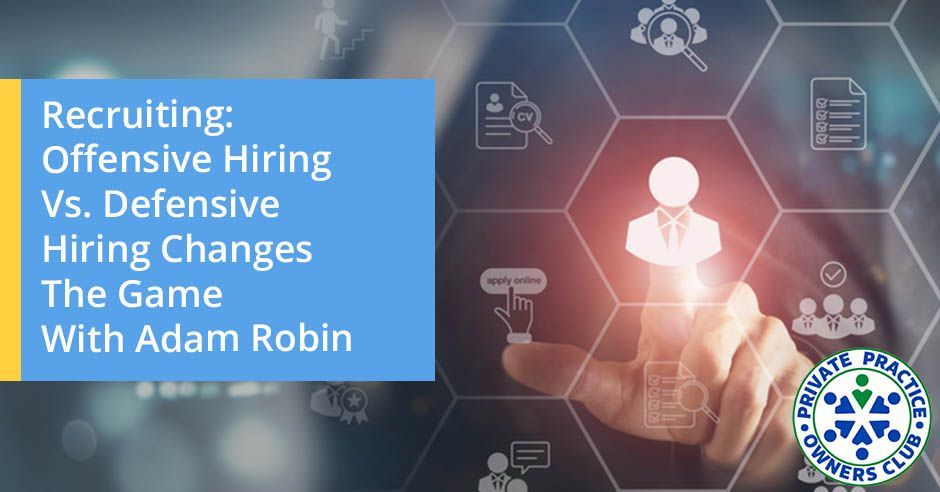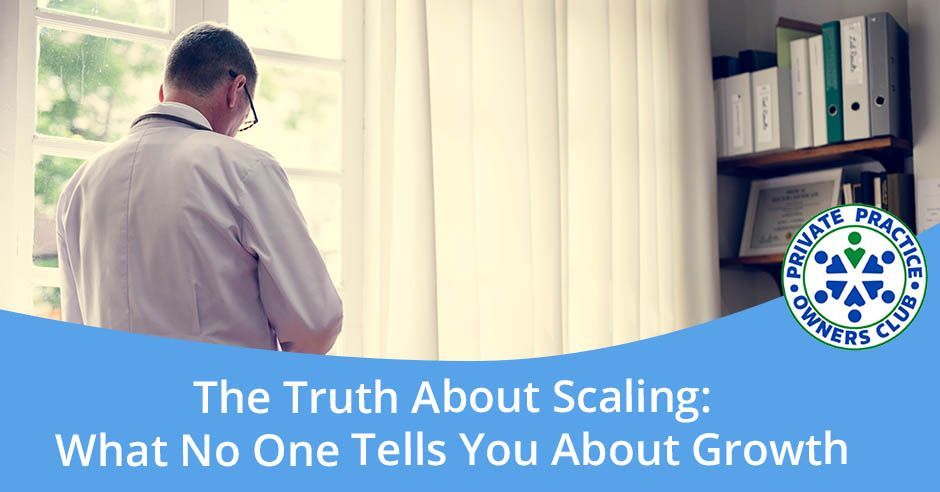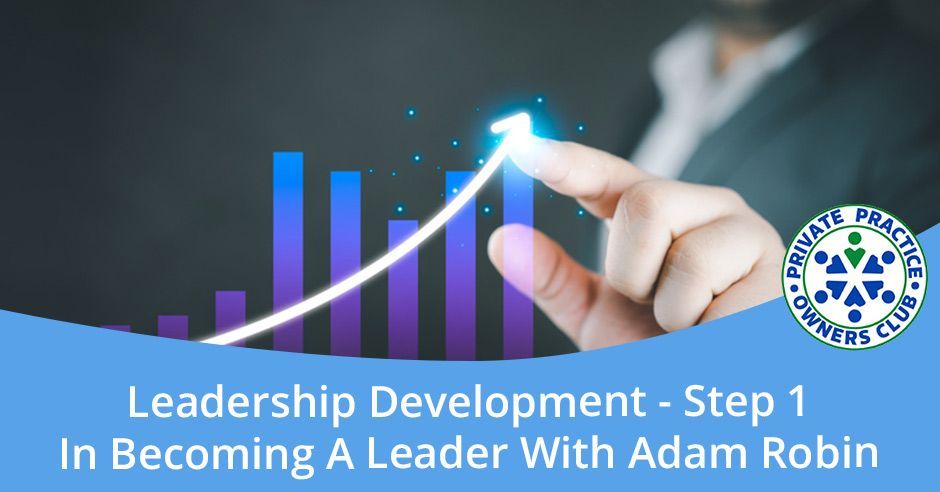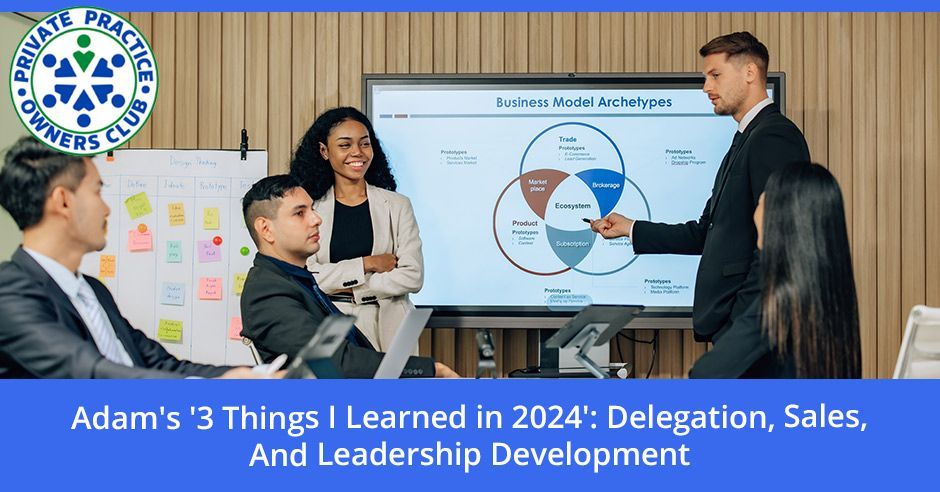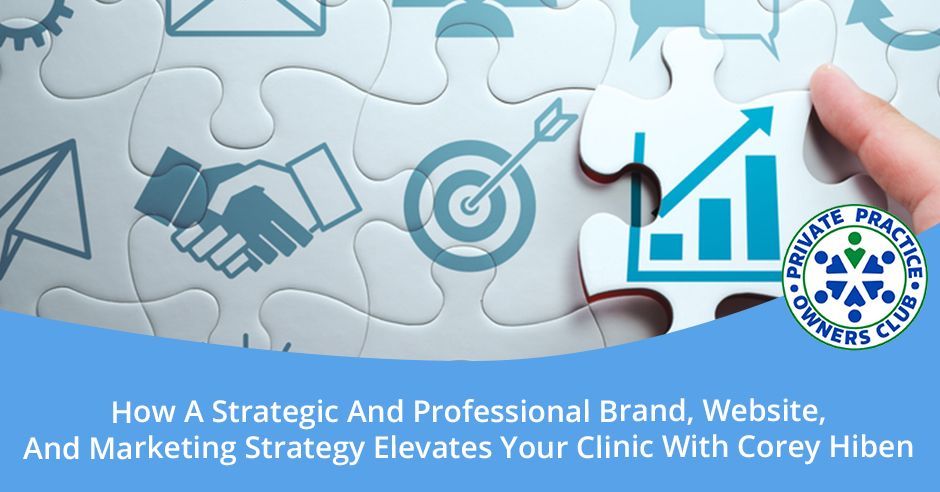Welcome back to the next episode in our series of the quintessential, bulletproof Practice Owner’s Manual for Success. Hopefully, you appreciated the previous episode, took lots of notes, and did some homework. Get ready to do some more work on your business. Get a pen and paper. Let’s go.
---
Welcome back to the show. How are you doing?
Charged up. Let’s roll.
We are in the Practice Owner’s Manual Series. This is part 7, the 2nd half. In the last episode, we talked about practice management in terms of creating values, vision, org boards, SOPs or Standard Operating Procedures, employee handbooks, policies and procedures, and all that stuff. Job descriptions, did I say that? We talked about all those things to establish the foundation of your company, especially if you’re considering growing in any respect in terms of size within one clinic or multiple clinics.
Go back and check that out prior to this one because this is part seven of the Owner Manual Series, which, in totality, should be a good foundation for anybody who is building their clinics, starting a clinic, and looking at the fundamental parts of the business and growing it from there. Go back and check that out. It’s been a while since we released an episode, so apologies for that. Let’s get into it.
In this episode, we’re going to talk about practice management. The first part was establishing that paperwork, the grind of putting your thoughts down on paper, and how we want to do things. This time, we’re talking more about the employee experience. We’re going to talk about hiring, onboarding, and retaining.
We might get into exit stuff as well, considering the employee lifecycle. We are going to save recruiting for a separate episode because we know everyone needs to work on that. That can be a whole different process unto itself that needs some special attention. We’re going to talk about the employee experience. Is that how you envision this going?
Yeah. How I have it in my head is chapter 1 or step 1, we’ve built the foundation of what it looks like to manage your practice with your org board, job descriptions, key statistics on each role, and that kind of thing. If you can imagine, we’ve got this template. We have to find the right who’s to plug into each of those roles, and we have to manage them appropriately. That’s a skillset that needs to be learned. It needs to be organized and systemized in order for you to get the outcomes that you’re looking for,
To say it ahead of time, it’s really important that as we’re looking at the beginning of an employee life cycle, which usually starts in the hiring stages, posting the ads, or working your networks to find that next employee, being clear as to the personality type that you’re looking for each position, the certain value traits that they have, the values that you have, and how you see that in the potential employees that you’re going to bring on We’ve talked about avatars in the past or your ideal client or ideal patient. It’s also to think there should be a particular avatar as it relates to these certain positions within your company, would you say?
100%. I would invite you to turn back to, I believe, chapter one. We talked about developing your culture, your purpose, your values, your story, and your identity. This is the perfect time for you to pull it back out and remind yourself of what that is. You’re looking for the right people who align with that, who have similar beliefs, and who hear your story and are like, “That’s really cool. That excites me.” You want to hire the people on your team who are value-aligned.
Exactly. Considering the hiring process, I’ll start there. When we are looking for people in certain positions, you tell me a little bit about how you built out those ads, how you advertised for positions in your clinic, and what seemed to work best.
Getting a little bit into recruiting, job boards is a big piece of that. It’s one of the buckets of recruiting. If you’re going to hire somebody, it’s probably a good idea to have a job ad out somewhere on Indeed, LinkedIn, Monster.com, APTA, job board, and that kind of thing. The thing is, you want to write that ad in a way that represents the values of your company. Who are you? What do you believe in? What are the types of people that have these beliefs? You want those people to click on your ad.
The job ad is a huge piece of it. Not only that, but doing some networking, communicating with some of the schools, sending out emails, and connecting with other therapists on LinkedIn. The point is you want to let people know that you’re hiring so that they’ll raise their hand and say, “I’m interested in talking to you about what that position looks like.”
It’s imperative to leverage your network a lot. I don’t think we do that enough. Knowing what you’re looking for really helps because then, you can write an ad that is targeted directly at them. The last thing you want to do on an ad is say, “We need someone who’s licensed, can type 50 words a minute, knows Microsoft Word, and is capable of building out spreadsheets.” That’s the kind of stuff you talk about later on down the road.
You first want to find a person who loves working with people. Do they love helping people overcome physical disabilities? Have they had experiences with physical limitations of their own? Have they had experience with physical therapy in the past? Have they had experience in any kind of realm that you are working in so that they can be promoters of exactly what you’re providing at least and know the product? Part of it is good with money. Especially if you’re at the front desk, you better be good at talking about money and find ways during the hiring process to figure that out.
We’re talking about ads. Our ads specifically did highlight our values. We would say, “We believe in professionalism, accountability, growth, and empathy. It shows up in these ways. This is our vision. If you want to be a part of that, then reach out to us,” or, “If any of this rings true to you and you think you’re a rockstar, we want you to send in a resume.”
That’s right. It’s the bait that’s on the fishing pole. Maybe 100 people look at that ad, 50 people, or whatever, but you really only want the two people who read that who say to themselves, “I want to talk more about that. I don’t care what they’re paying. I don’t care when the interview is. I want to hear more about what this person is talking about.” Those are the two people you want to talk to, right?
Yeah. You’d rather have those two people who are excited versus 100 resumes because you have the add-up.
People who are like, “I’m looking for anybody who could pay me a check,” you don’t want those people.
You filter them out. You are talking specifically to them, so you are going to get fewer resumes. However, the resumes should be much better qualified.
Speaking of resumes, if you’re doing any type of job posting, the whole point of it is to get a resume, to get a lead, or to get somebody who applies, an applicant, and go through that hiring process. Step one is reviewing the resumes and making sure that somebody put together a decent resume. It’s got everything that it needs. It’s got a cover letter. It’s got all the credentials. You want to do a resume review. That’s the first step.
You tell me, but a resume and a quick phone call usually wouldn’t last more than fifteen minutes. I get a sense of them pretty quickly.
Phone screen.
Maybe even a Zoom call if you can. It’d be nice to see their face and how they present themselves before you bring them in person. Is that how it went? At what point did you ask for references? Was it not until after the in-person interview?
Yeah. Maybe after the interview.
If they were a go?
Yeah. If you can imagine, on your Owner’s Manual, it says hiring process. You’re going to post a job ad and do some resume reviews. There are maybe a few criteria on what you want to see on a resume, like what would disqualify them and what would qualify them. Of those qualified resumes, the next step would be an initial fifteen-minute phone screen. You’re like, “Who are you? Why’d you apply?”
If you like what you hear and they sound aligned with you, follow up and invite them to an in-person interview. That would be the next step of the process. During that interview, you would have to have a series of specific questions that you would want to ask. Write the interview questions down and come prepared with the specific questions for your company. From there is a working interview and then potentially an offer if they get through the process.
That was our exact same process. I found those interviews initially as a newer owner to be nerve-wracking. I didn’t know what to ask. I’d ask the same silly questions, like, “What are your strengths? What are your weaknesses?” I got the same stupid responses. There were a couple of times when I wished I had the guts when someone showed up. These were usually for tech and front desk positions. They would show up in jeans and a T-shirt. I wish I had the guts at the time to say, “This isn’t going to work today. Thanks for driving over here, but we’re done. It’s not a good fit. Sorry.”
One other thing that I know people have done in the past, and we did it occasionally but especially if we’re getting a lot of resumes for a particular position, towards the end of the ad, we would say, “Put an asterisk in the upper right corner to show that you’re serious about applying for this position.” If they didn’t have an asterisk in the upper right corner, then immediately, their resumes got tossed out. We didn’t even read them. There are some filtering processes that you can use to weed out so many of those resumes if you need to.
You can increase the barrier to entry and make them jump through a few more hoops.
The fifteen-minute phone call is a screen. There’s no commitment to the in-person interview during that phone call. It’s like, “You sent in your resume. I’m doing a follow-up call. I wanted to talk to you a little bit and gauge your interest, what made you interested, what you like about the potential position, and what got you interested in the ad.” If it feels good, move on to the in-person.
I really appreciate you saying to write out the questions ahead of time. I’m assuming you have some examples in our vault for answers to those questions. Many of them, I would recommend being value-related. You might have to get a little bit creative instead of saying, “If your value is professionalism, how did you demonstrate professionalism in the past?”
Maybe consider bringing up an actual situation where you’re like, “Sometime in your past, did you or another employee act inappropriately? How did you guys handle that so that it didn’t devolve into something dramatic?” See how they respond and see if it falls in line. Also, as we talked about values, I was watching their body language. Are they engaged? Are they sitting back with their arms crossed? Are they looking up at the ceiling, looking at their fingernails, or checking their phones? I’m watching the body language to see if they’re engaged and interested in the position, me, and the company.
It’s important to objectify and standardize that whole process. Write the questions down. Write down the specific criteria that you ask on the phone screen and in the interview process. If you don’t, then the hiring process will typically tend to drift towards an emotional decision if you don’t standardize it. If you objectify it, then you can improve it.
If you end up making a bad hire, then you can look at the process and change the interview questions or change the resume screening process to improve the outcome. If it’s all over the place and it’s however you feel on any given day, then you’re going to have those types of results. It’s flipping a coin. You don’t know what you’re getting into.
I love how you pointed that out. Did you ever do or do you do group interviews at all?
We started that. You gave me that idea a couple of episodes ago. We built out a policy and we’re going to start doing some group interviews for admin.
That’s cool.
They’re for text and front desk positions.
That’s exactly for the higher turnover positions where they might drop out on you on a dime and not show up at the clinic. We wanted to have a stack of resumes to call at any given time. We found that to be really fruitful. We found some cool people. I enjoyed it. We would post the ad and say, “If you are interested, we are hiring. We’re going to have an interview process on such a date at such a time. If you’re available and interested, then apply. Send in your resume.”
Inevitably, we’d get a certain number of them. We knew if we had 15 resumes, there’d be between maybe 5 to 8 who’d show. We had a little agenda to it. We had them come in. We like to have fun, so we played Pictionary with them to break the ice. We do about 2 or 3 Pictionary things and see how they handle that.
That is cool. I like that.
We would talk about values and have a discussion with the group. These are our values. We also share a little bit about our story, like, “We opened up at this time.” It’s been 3 to 5 minutes talking about,
“We opened up in 2002. We have these clinics. This is what we’re looking for.” We’d have that discussion about values. We had them take a little test as well. It was about ten questions. It was a logic test. I don’t know where we got it, but we had them take this test and we would score it to see how they did. We never give them the results, but we score them. We’d ask them for any questions that they had.
It usually takes about 30 to 45 minutes. Within that time, usually, a couple of people would stand out. Those were the people that as we were walking out, we’d say, “Thanks for coming by. We appreciate it. These are the positions that we’re looking to hire. If we’re interested in working with you, you’ll get a call from us to do that fifteen-minute phone screen.” Some people we’d catch on the way out and say, “We really like you,” and do the in-person interview then. It helped with those positions to save time.
It’s all about the process. Write bullet points on your piece of paper and your hiring process. Step one is resume review. What exactly does it look like? What does a good resume look like? Write it down. They have to meet certain criteria. Number two, that initial phone screen, how is that conducted? What questions do you ask? What are some of the criteria that would qualify them for an in-person interview? They’d have to answer it in a certain way and a certain tone. They schedule the interview and then we have a process for that.
We have certain questions that are specific and are documented in a certain way. Maybe it’s a test or some type of format. We then maybe do some type of working interview, whether that’s an hour or two hours. That has a format as well. From there, if they get through all of that and meet all the criteria you’re looking for, then you can extend an offer.
The beauty of everything that you laid out is that since you have that system, you don’t have to do it anymore.
That’s right.
You can hand this off to someone else.
You can manage the system. Instead of all that stuff that’s rattling around in your head all over the place, it’s right there on a piece of paper. You can manage that. It’s so much easier to manage once it’s out of your head. You can do that in 2 or 3 hours. You could put all that together very simply.
I love it. I can’t emphasize it enough, and I’m not sure enough owners do it. The working interviews are a huge game-changer for us. Some people can fly through those interview processes, especially one-on-one, and do great, but we miss some serious red flags until that job shadow or that working interview where we’re like, “They showed really well, but once they were on the floor, it didn’t work.” We’re really glad we did the job interviews at that point.
It makes it so clean. I’m guilty of this. They’re like, “What do you think about this candidate? Should we hire him?” I’m like, “Follow the process. If we make a bad decision, we’ll fix the process.”
The team really appreciates being part of that process. They know what kind of person works well and the culture of the company better than we do because we’re on the outside sometimes. They know what the dynamic is in the clinic. They can say, “This person might have a rough time,” or, “This person spent a lot of time on their phone the entire time. That’s an issue.”
The people who hit a home run were the people who showed up to the job shadow with a notepad and pen ready to take notes. We’re like, “We need to make a call to confirm this appointment. Do you want to make it this time?” They’re like, “Yeah. Give it to me. Let’s go.” Those are the kind of people you want to see on a job shadow.
That’s right. They show up with a pad. They ask some good questions. They have some goals. They have some direction in their life and their career. They’re interested in what you’re doing. They want to be a part of some of the serious stuff you’re doing. They’re like, “I want to be a part of some of the strategic initiatives of the company. What are you guys doing? How are you guys going to grow? How many people are you hiring?” They’re asking those types of questions.
You want to see those types of people, for sure. We were talking a little about this hiring process and the onboarding process, but in between, what do you want to say about the job offer and procuring?
There’s a good way and a bad way to do it. I don’t think there’s a right or wrong. I can tell you what we do. We always get a verbal offer first. We want to get a verbal agreement on what that offer looks like, like compensation, benefits, and the whole nine yards. We want to get a verbal offer. Once we get a verbal, then we’ll extend something in writing that outlines the details of our conversation. We’ll give them a day or two to approve it. We’ll have an expiration date on it. Once we get that signed and approved, we start the onboarding process.
Interview Process
Pretty clean and simple. We’re going to save recruiting for another time. As part of the interview process specifically for providers, do you bring up production expectations during that interview process as well? You’d hate to have the production conversation during the onboarding process and they’re like, “Do you want me to see 100 patients a week? I didn’t sign up for that.” You’re like, “It’s a little too late to bring it up then.”
It’s a good idea to bring up the production. If you start hiring people and you’re having production issues, then you have to go upstream. If they’re already on your team, it’s because they went through your onboarding process and they weren’t prepared. Their expectations weren’t managed. If you’re hiring people and you’re hitting a bunch of home runs, and all of them are great and are hitting production, then I wouldn’t fix a thing. If you’re having those types of issues, then that’s a very good indication that that needs to be built into your onboarding and/or training process.
Onboarding Process
I loved how you set up your onboarding process. We’d spend a full day going over the employee handbook, some of the values of the company, and some of the important policy and procedures portions. That would be whether you were a provider, front desk person, or technician. It didn’t matter. You were going to go through that one day of onboarding.
This was usually done by our leadership team. Initially, it was handled by me and Will, but we also systematized that and handed it over to our leadership team. They knew they were going to spend a day going over what it’s like to work for Rise Rehab Day and get them onboarded that way. We then work them into maybe working with their clinic directors to get them involved in the clinics. Can you tell me a little bit about your structure?
We’ve got ours built out in three phases. It’s a 90-day onboarding process. This is a simple, zoomed-out version. In the beginning, phase one, the biggest mistake you can make is to hire somebody and then the next day, give them 50 patients to see. You’re setting yourself up and the patients for a really bad time. Show them where the bathroom’s at.
They’re like, “Where do they put their stuff? Where do they park?”
Give them some time. Let them get oriented. We usually give them a good week. It’s not that they’re not going to see any patients for a week, but we’re going to give them some space. We’re not going to jump into that.
You’re going to give them time to sit down with the EMR webinars, right?
Correct. Watch a few trainings.
Schedule some time in their day so they can spend 1, 2, or 3 hours, whether it’s front desk, tech, or provider. Sit down with the EMR and get used to it. It’s stuff like that.
It’s helpful on that first day where it’s like, “I’m so excited to be here with you today. Let’s hang out. Come on back.” Give them time to walk around the clinic, introduce themself, go to the bathroom and see where that’s at, and go find the hydrocollator. You don’t have to jump down their throat and start getting them busy.
The main thing is, during that first week, you want to get all your HR and admin stuff onboarded, get the credentialing stuff started, get a copy of the license, and get their logins. You’re like, “Make sure you’re going through that employee handbook, that job description, and the org board that we made and polished up for everybody. This is where you’re at. This is where you fit in the company. Here are some of the expectations.” That’s phase 1 for your first 7 days.
Phase two is going to be your roles and responsibilities. That’s going to be a three-week process. That’s where you’re going to go through the EMR. Watch them do an eval. Make sure they’re documenting on time. Make sure they know their KPIs, how to measure them, how to report them, how to participate in the weekly meetings, and how to do their job on a technician level or basic level.
Would you be using the job description as your checklist?
Yeah. It’s EMR, documentation, policy procedure, time off, billing, KPIs, and meetings. That’s what you need them to learn. You need to learn those things. This is how you do your job. For the first 30 days, they’re onboarded. They’ve shadowed. All their admin stuff is together and they know how to do the basics of their job.
The final phase is a two-month process where we focus on performance. You’re like, “Now that you’re oriented, you can go through this clinic on a day-by-day basis and not kill anybody. You know where the bathrooms are. You know how to log in. Now, let’s talk about the sales program, the internal marketing program, patient experience, production, and all of those things.”
It’s like, “What do we expect out of you?”
Correct. This is how we really contribute value to the company.
A thought came to mind. Do you guys do much role-play during these 90 days?
Not a whole lot of role play initially, but what we do is sit in on their evaluations.
You’re talking about providers specifically there.
We do a checklist to make sure they’re hitting certain metrics during the evaluation, the intake process, or whatever their role is like.
During the onboarding process, we also found a lot of it during the weekly meetings. Especially if someone’s new to the front desk position and they haven’t asked for co-pays before and they haven’t come up against objections to co-pays and stuff like that before, role-playing would be an important part of this so they’re not doing trial and error on real patients.
We do have a role-play process. We do that once a year with the entire company. It’s not part of that initial onboarding process, but every year, everybody in the whole company does it. That’s how we have it set up.
That’s super cool. What do you see as the benefits of having this onboarding process mapped out like this and taking 90 days to do that? What have you seen the benefits of that being?
I got off the phone with a client. We’ve done a lot of work over the last few months and we built out his onboarding process, his clinical sales, training, purpose values, the whole thing. I said, “What’s your onboarding process going to look like? You’re not the same company you were when you hired your last person. You’re a different company. That means the process is going to be different.” We went through that.
I got on the phone with him and said, “How’s the new person doing?” He said, “It’s amazing. It’s working.” It’s his first week and he’s already trying to figure out ways to maximize his units and try to get people bought in. We started cracking up laughing. It’s such an awesome experience whenever you put all that work into this type of thing and deliver so much value to the employees, the patients, and the team. You’re pouring so much energy into them. To watch it come to life and see everybody win is so cool.
I remember there was a point in my career when I stopped, looked around, and saw everybody doing their job. I wasn’t even needed there. That was the starting point when I realized, “What we do here is pretty special. It’s pretty awesome.” I feel really good about who we are and what we do once I saw everybody buying into it like that.
I can imagine in that situation you felt really confident then as you were hiring and recruiting other people and being like, “We’ve got an amazing team. We’ve got an amazing company. These cultures can’t be beat.” We felt like that as well. There’s no reason anyone would not want to work with us.
It’s because you’re so clear on who you are and what’s important to you. The first training program you build is provider onboarding. Once you go through that, you can do it for your clinic director, your recruiting person, and your marketing team. You can start building out these trainings. I know we’re going on a different topic, but the point is it’s worth your time.
The team members that came on to our team as well would start saying things even on the first day. They’re like, “This is different. You guys do things differently here. You guys are really professional.” We’re like, “Really? We’re doing the best we can here.” They notice the difference because they’ve been in the clinics and the companies where they get thrown to the wolves. You don’t want that.
Your team members want direction. They thrive on leadership and guidance. They want to learn. The less of that that you give them, the more prone they are to figuring it out themselves, not doing it the way you want them to do it, and creating a culture that’s unintentional. That leads to burnout. It leads to stress and anxiety. The more support you can give in those situations, then the more confidence they have in what they’re doing. They want that playbook. They want to be told what the plays are in the playbook because these are the plays that will make us successful. They’ll follow them if you provide it.
To continue on that, one of the coolest things that I see, and I don’t mean this in an evil way, is they become indoctrinated into your culture. They become deeply connected or emotionally connected. You’ll see people on the third day that they come in and they’ve got their company shirt on. It’s all, “I’m Southern Physical Therapy proud.” As an owner, when I walk in and I see somebody representing us like that on their first week, I’m like, “I love you. You’re awesome.”
I talked about it before. What’s also cool about building out all these systems is eventually, as you grow and expand, these hiring systems are going on and you don’t know it. People are getting hired without you even knowing. It was so weird for me to come across a new employee in the company who had been with us for three weeks and it was the first time I’d ever met him.
That onboarding process is key.
They’re awesome.
It’s a system. It’s the same thing. In the beginning, we’re like, “Let’s schedule out the meetings. Let's schedule the weekly check-in. Let’s schedule out the 90-day check-in. Let’s review the evaluation check-in. All the check-ins, schedule them out. Schedule out the time to do the EMR,” and this and that. Follow the process.
Checklists make that easy.
Right under your hiring process, you have your onboarding process. You don’t have to have it all built out, but it’s important for you to at least have a framework. Phase one, the first week, is HR and admin. Phase two is going to be weeks 2, 3, and 4. That’s going to be roles and responsibilities, job descriptions, and all that stuff.
Practice all that stuff.
Phase three is going to be months 2 and 3. That’s going to be all about performance. If you break it down like that, it’s a good framework to ramp it up. Get all the stuff out the way in the beginning, ramp it up, and get to performance. The goal is fully productive within 90 days without overwhelming your team or the therapist. That’s the big P. The product is ramping up the therapist as quickly as possible without eliciting any overwhelm or anxiety for anybody on the team. That’s the product.
Retention
We went through hiring and onboarding. Lastly, how do we keep them? Retention. WHAT secrets do you have in terms of keeping people, especially A-players on your team?
We can have a whole episode on this. I don’t know if you guys remember, but we talked about the patient life cycle. Guess what? You have an employee life cycle. They onboard. We check in with them every week. We have weekly meetings. We have a monthly one-on-one. We have quarterly or annual reviews every year with them. The thing is that you have to make time to meet with your team and hold that space for them to be heard and for you to communicate clearly with them. If you do that and be a decent leader, they’ll stick with you. They’ll align with you.
Number one, set some goals. What are their career goals? What are their personal goals? What are their professional goals? Number two, make sure you’re having a weekly team meeting blocked off with an agenda. You give them time to give you some feedback on how they’re doing every week and how they want to be a part of the team. If you get those two things right and commit to that, you’ll really improve your employee experience.
I don’t think we did monthly meetings. Maybe we did. I can’t remember. I’m getting old. Maybe this is a little bit backward, but our goal was we didn’t want any employees to be surprised that they were being let go. They should know where they stand in the company most of the time either through objective KPIs or enough accountability meetings or one-on-one meetings where we’ve had to talk to them about how they’re doing.
It’s not necessarily based on that, but that being one of our driving factors, we felt it was important to talk with our team members on a regular basis and get a feel for where they’re at. One of my friends, as part of his annual review, asked them a typical Dan Sullivan question. It was, “If we have this meeting again in a year, what would have to have happened in order for it to be a success in your life?”
It’s a great interview question too.
Exactly. He said, “We’re sitting here in a year. What has to have happened in the last twelve months for you to say that wasn’t an amazing year in blankety-blank clinic?” Talk it out and figure it out. That’s a good way to establish some goals for them because you’re not going to impose the goals upon them. You’re also going to talk about the KPIs and where they’re standing. You’re also going to talk about values and how they’re living those out and where they can improve. Ours was a very value-based assessment of how they were doing in the company. We talked about that. We kept notes of that.
In the annual review questionnaire, we had them fill it out before the annual review and turn it in before the meeting so we could review it. We filled it out as well. Each of us would fill out the same questionnaire regarding that team member’s performance in the past year, and then I would review both of those before the meeting and then come to it.
In those meetings, it was the responsibility of the team members to report what they did and report the answers to that questionnaire to us. We established, “This is you reporting to us about what you’re doing and how you feel you did in the past year. When you’re done, then I’ll share with you my perspective as to how you did in the past year.” We liked having that dynamic. We liked having a value-based assessment process. It’s helpful to have the team members do a lot of reflection and not just yourself.
The one thing that I add to that is I will do an annual review on myself and I share that with them as well. It’s like, “This is what I’m working on. These are the values that I’m trying to work on right now.” Also, I’m like, “How can I be a better leader for you? How can I hear you better? How can I push you without pushing you too much? How can I do better for you?”
Great question. It’s like, “What more do you need from me?”
I’m like, “What do you need from me to help you reach this? Can I listen better? Can I give you something a little different? What am I missing?”
Some great, old generalized questions are like, “Here’s what I need from you. What do you need from me? What is your focus over the next year?”
What does success look like together? What we always do is how we are going to celebrate. We’re like, “Let’s plan the celebration. What are we going to do? Let’s go to the movies. Let’s have a pizza party,” or whatever it is. The employee experience and annual goal setting with maybe some employee review framework are pretty important. Also, some type of check-in, whether that’s monthly or quarterly. Check-in with them.
Then, a team meeting. We do it weekly. Every week, we block off an hour. We’re going to have a team meeting with a meeting agenda. We’re going to review the calendar together. We’re going to review the initiatives. We’re going to give everybody an opportunity to talk and speak. We expect them to present their concerns. We do that and everybody gets better, right?
Yeah. At that point, when those systems are running, the power of the culture takes over. Interestingly, the power of the culture is felt by the strength of your systems, don’t you feel?









